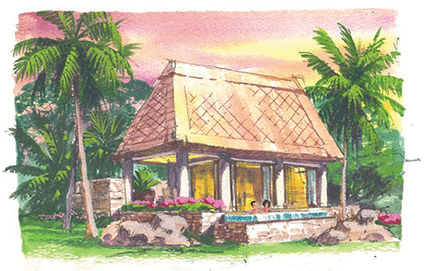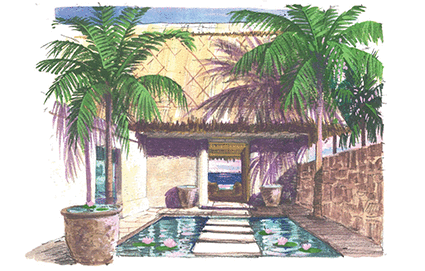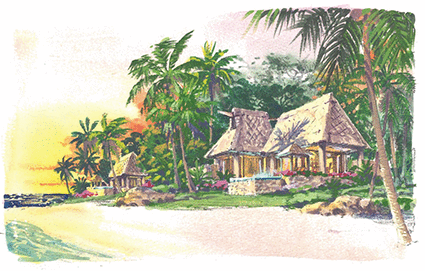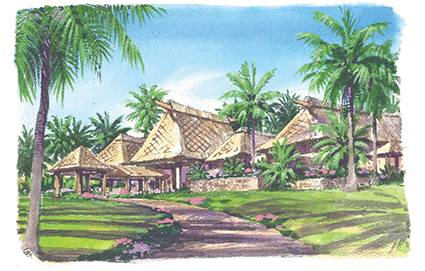







In the pristine northern lau group of the Fiji islands, at 178° 42’ 54" W and 17° 31’ 12" S.
It is approximately 225 acres (one mile long by one third mile wide). The elevations are gradual, with the entire island being accessible and @ 90% developable. The top of the island is approximately 55 meters (180 feet) high, offering panoramic views of the surrounding lagoon and nearby islands.
The entire lagoon is sandy bottom (with spectacular coral bommies scattered around), meaning the beach is not lost with tidal changes, making the lagoon very unique and desirable, and allowing access to the water from nearly any part of the island. The depths range from an average of 6 meters (20 feet) on the western side to 27 meters (90 feet) on the eastern side. The western side, with soft white sand beaches is ideal for swimming, snorkeling, and other water sports while the eastern side, with a 121 meter (400 foot) jetty, can easily accommodate yachts up to 200+ feet. The entrance to the lagoon is 35 feet deep by 200 feet wide.
Guest Bures are: 1250 and 1350 Sq. ft. & the Main Complex is 40,000 sq. ft.
In addition to the resort development (80% complete), there is a three story airplane hangar (upper levels are used for storage of building materials and inventory), power generation building, decompression chamber facility, laundry building, fuel storage tanks and distribution system designed by shell oil (plumbed to the end of the jetty for easy fueling of vessels), employee housing, triplex intended for use by resort gm, island doctor, and surgery/medical center.
The resort design was a collaboration of Dana Aiken (a CA based architect who worked on many prestigious properties, including Euro Disney and Disney World in Florida), Phil Bias (a landscape architect who has been involved in the design of Jack Nicholas Courses and Resort Properties for Don Kohl, a southern California property developer), and RIM Architects of Hawaii who were utilized for the structural engineering. The structures have been built to: California earthquake standards and according to USA, Australian, or New Zealand building codes, whichever were the most stringent. Existing structures are made of stone, concrete and epoxy coated steel in order to prevent rust or dilapidation.
size capacity etc.
ie: How would the new owner get approval etc?
Any types of structures are permissible as long as said structures are sound and compliant to the existing building Codes. Fiji does use a British Law system and all completed plans are to be submitted and registered with various Fijian government authorities and departments.
As well as the water making and storage facilities, power generation plant and distribution scheme, and telecommunications cable, there are seven (7) kilometers of road on the island.
Yes, and this has been done with great success in Fiji and other resort destinations as a means to recoup investment and fund additional development, if desired.
All utilities on the island are underground. There is a complete power plant, custom designed by Cummins of Australia. It includes three (3) diesel generators (which can be expanded depending on how much additional development is done on the island) that produce 315 volts, which is transformed up to 6500 volts and then finally distributed around the island to strategically located transformers where power is dropped to a utilizable voltage to suit the particular application.
The entire island currently has underground fiber optic, telephone, and TV coax cable which can be expanded to meet any future increases in demand.
There is a 1.5 million liter reservoir located on island that collects catchments and the unused water produced by the water purification system. There is also a desalination plant that can supply up to 100,000 liters per day. Seventeen (17) miles of underground water pipe carry fresh water around the island.
The resort facilities uses two different approaches to the sewage disposal. Each villa on the beach has a bio digester for up to 30 persons installed at least 15 meters from the high tide line with leach lines. The main complex has a 300 person unite for its operations. The over water unites will have a rotational unite as it will have a larger amount of effluent to process. All processing is done by high microbe digestion and not chlorine (as any chlorine seepage will damage the reef system if it leaches out into the sea).. All systems have been designed to and approved by the Government Health Department building codes.
All garbage is separated into three components: All metal, plastic and glass is bundled up and shipped to the main island recycling center… All paper products are mulched and combined in the composting media for later usage to fertilize the gardens. All food scraps are collected as food for the island’s Lovo Pig farm. There is a Ship that will visit the island monthly to deliver food, fuel and return any trash for disposal to the main island facilities.
There are only employees of the company living on the island at present. There has never been a native village on the island and the current owners have always enjoyed a good relationship with the locals on the surrounding islands.
There are parrots, doves, swallows, king fishers, herons, pacific rails, fruit bats, iguanas, coconut crabs, and geckos on the island. In the lagoon there is a myriad of marine life, including turtles (predominantly leatherback and green), parrot fish, lobster, trumpet fish, giant clams, puffer fish, butterfly, lemon and blue damsels, moorish idols, anemone, and clown fish just to name a few! As an added bonus, every September a large school of dolphin (about 60) give birth in the western side lagoon – a sight that very few people in the world have ever had the opportunity to see! Outside the lagoon there are huge marlin, swordfish, skip jack, tuna, and mahi-mahi thanks to a 20 year moratorium on commercial fishing – it’s a sport fisher’s and scuba diver’s dream.
Because Fiji covers a large area, the weather varies, but for the most part it is tropical, like Hawaii. However, the seasons in Fiji are the opposite of the northern hemisphere. The island is located in the eastern part of the country which is not as dry as Nadi or as wet as Suva, enjoying year round trade winds that make it very pleasant.
There are direct flights to Fiji from most major gateways (Australia, New Zealand, Asia, Canada, and the USA). From Nadi International Airport (NADI) to the island it is approximately an hour and a half (150 miles from main Island /Airport)… depending on what type of plane is being used: (turbine, turbo or sea plane). It is recommended that all jets remain at the International airport as the engines need to be frequently services by a British Certified Mechanic due to the climate.
The runway is currently 1000 meters (3400 ft.) long. While the grass runway was useable in good weather, it has now been extended and is being upgraded to an all weather strip. It will take approximately four months to complete (compacting, tar sealing, and final cafi approval). Runway can be further extended to approximately 1 mile in order to accommodate Gulfstream Jet aircraft.
Freehold land conveyances in Fiji are relatively straight forward. Once you have done your due diligence (a site inspection is highly recommended) and entered into a purchase agreement with the sellers, the sales transaction will be handled by an attorney who is licensed to practice in Fiji; there is no escrow in Fiji.
The island is being offered at $17,000,000.00. The current owners may consider carrying back part of the purchase price with suitable security, the terms and conditions to be agreed upon.
No, the island is unencumbered freehold/fee simple property.. Less than 7% of the land in Fiji is freehold, with the rest held as leasehold by either the Fiji government (crown lease) or the native land trust board (native lease). Being freehold, the owners have an enormous amount of discretion as to the type and extent of development on the island.
Further detailed information (concerning all of the above) shall be provided for serious & qualified inquiries.